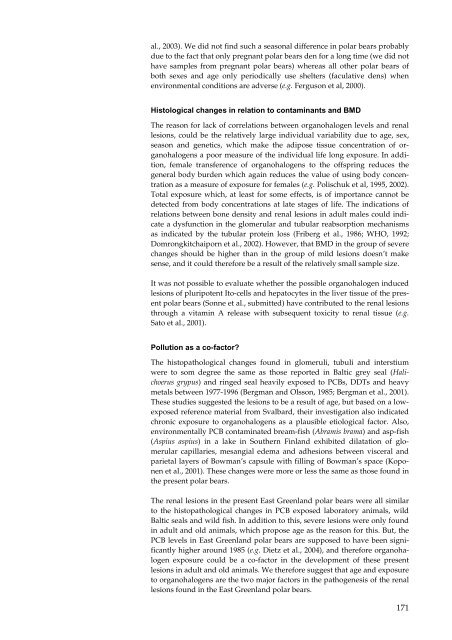Organohalogen concentrations and a gross and histologic ...
Organohalogen concentrations and a gross and histologic ...
Organohalogen concentrations and a gross and histologic ...
You also want an ePaper? Increase the reach of your titles
YUMPU automatically turns print PDFs into web optimized ePapers that Google loves.
al., 2003). We did not find such a seasonal difference in polar bears probably<br />
due to the fact that only pregnant polar bears den for a long time (we did not<br />
have samples from pregnant polar bears) whereas all other polar bears of<br />
both sexes <strong>and</strong> age only periodically use shelters (faculative dens) when<br />
environmental conditions are adverse (e.g. Ferguson et al, 2000).<br />
Histological changes in relation to contaminants <strong>and</strong> BMD<br />
The reason for lack of correlations between organohalogen levels <strong>and</strong> renal<br />
lesions, could be the relatively large individual variability due to age, sex,<br />
season <strong>and</strong> genetics, which make the adipose tissue concentration of organohalogens<br />
a poor measure of the individual life long exposure. In addition,<br />
female transference of organohalogens to the offspring reduces the<br />
general body burden which again reduces the value of using body concentration<br />
as a measure of exposure for females (e.g. Polischuk et al, 1995, 2002).<br />
Total exposure which, at least for some effects, is of importance cannot be<br />
detected from body <strong>concentrations</strong> at late stages of life. The indications of<br />
relations between bone density <strong>and</strong> renal lesions in adult males could indicate<br />
a dysfunction in the glomerular <strong>and</strong> tubular reabsorption mechanisms<br />
as indicated by the tubular protein loss (Friberg et al., 1986; WHO, 1992;<br />
Domrongkitchaiporn et al., 2002). However, that BMD in the group of severe<br />
changes should be higher than in the group of mild lesions doesn’t make<br />
sense, <strong>and</strong> it could therefore be a result of the relatively small sample size.<br />
It was not possible to evaluate whether the possible organohalogen induced<br />
lesions of pluripotent Ito-cells <strong>and</strong> hepatocytes in the liver tissue of the present<br />
polar bears (Sonne et al., submitted) have contributed to the renal lesions<br />
through a vitamin A release with subsequent toxicity to renal tissue (e.g.<br />
Sato et al., 2001).<br />
Pollution as a co-factor?<br />
The histopathological changes found in glomeruli, tubuli <strong>and</strong> interstium<br />
were to som degree the same as those reported in Baltic grey seal (Halichoerus<br />
grypus) <strong>and</strong> ringed seal heavily exposed to PCBs, DDTs <strong>and</strong> heavy<br />
metals between 1977-1996 (Bergman <strong>and</strong> Olsson, 1985; Bergman et al., 2001).<br />
These studies suggested the lesions to be a result of age, but based on a lowexposed<br />
reference material from Svalbard, their investigation also indicated<br />
chronic exposure to organohalogens as a plausible etiological factor. Also,<br />
environmentally PCB contaminated bream-fish (Abramis brama) <strong>and</strong> asp-fish<br />
(Aspius aspius) in a lake in Southern Finl<strong>and</strong> exhibited dilatation of glomerular<br />
capillaries, mesangial edema <strong>and</strong> adhesions between visceral <strong>and</strong><br />
parietal layers of Bowman’s capsule with filling of Bowman’s space (Koponen<br />
et al., 2001). These changes were more or less the same as those found in<br />
the present polar bears.<br />
The renal lesions in the present East Greenl<strong>and</strong> polar bears were all similar<br />
to the histopathological changes in PCB exposed laboratory animals, wild<br />
Baltic seals <strong>and</strong> wild fish. In addition to this, severe lesions were only found<br />
in adult <strong>and</strong> old animals, which propose age as the reason for this. But, the<br />
PCB levels in East Greenl<strong>and</strong> polar bears are supposed to have been significantly<br />
higher around 1985 (e.g. Dietz et al., 2004), <strong>and</strong> therefore organohalogen<br />
exposure could be a co-factor in the development of these present<br />
lesions in adult <strong>and</strong> old animals. We therefore suggest that age <strong>and</strong> exposure<br />
to organohalogens are the two major factors in the pathogenesis of the renal<br />
lesions found in the East Greenl<strong>and</strong> polar bears.<br />
171

















